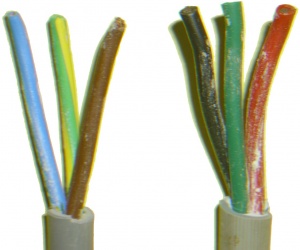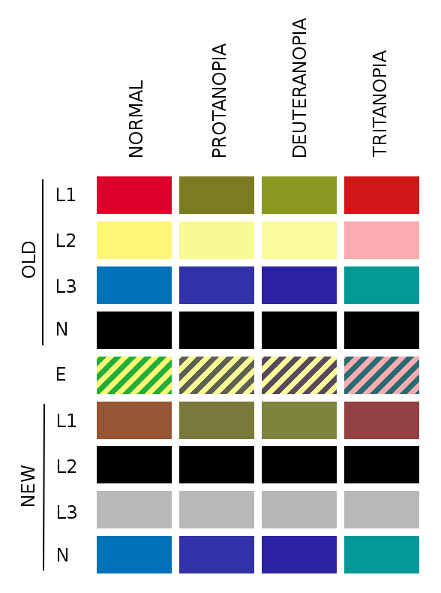Difference between revisions of "Wiring colour codes"
(Added colour blindness section) |
m (→Early Electronic wiring codes: Reformatted in a table) |
||
| (2 intermediate revisions by 2 users not shown) | |||
| Line 2: | Line 2: | ||
Modern: | Modern: | ||
| − | * Brown: live | + | * Brown: live 1 |
| + | * Black: Live 2 (3 phase) | ||
| + | * Grey: Live 3 (3 phase) | ||
* Blue: neutral | * Blue: neutral | ||
* Green/yellow or bare: [[Earthing and Bonding|earth]] | * Green/yellow or bare: [[Earthing and Bonding|earth]] | ||
Old: | Old: | ||
| − | * Red: Live | + | * Red: Live 1 |
| + | * Yellow: Live 2 (3 phase) | ||
| + | * Blue: Live 3 (3 phase) | ||
| + | |||
* Black: neutral | * Black: neutral | ||
* Green or bare: [[Earthing and Bonding|earth]] | * Green or bare: [[Earthing and Bonding|earth]] | ||
| Line 15: | Line 20: | ||
The standard wiring colours in the UK are (as of 2006) the same as elsewhere in Europe and Australia and follow [[Regulations|international standard IEC 60446]]. This [[colour scheme]] had already been introduced for appliance [[flex]]es in the UK in the early 1970s, however the IEE recommended for [[cables|fixed wiring]] until 2006 a different scheme. As a result, the international standard blue/brown scheme is as of 2006 found in all but the oldest appliance flexes. In fixed wiring, the blue/brown scheme is only found in very new (post-2004) installations, and electricians are likely to encounter the old IEE black/red scheme in existing installations for many more decades. | The standard wiring colours in the UK are (as of 2006) the same as elsewhere in Europe and Australia and follow [[Regulations|international standard IEC 60446]]. This [[colour scheme]] had already been introduced for appliance [[flex]]es in the UK in the early 1970s, however the IEE recommended for [[cables|fixed wiring]] until 2006 a different scheme. As a result, the international standard blue/brown scheme is as of 2006 found in all but the oldest appliance flexes. In fixed wiring, the blue/brown scheme is only found in very new (post-2004) installations, and electricians are likely to encounter the old IEE black/red scheme in existing installations for many more decades. | ||
| − | + | Current IEC | |
| − | Protective earth (PE) Green/yellow striped | + | : Protective earth (PE) Green/yellow striped |
| − | Neutral (N) Blue | + | : Neutral (N) Blue |
| − | Single phase: Live (L) | + | : Single phase: Live (L) Brown |
| − | Three phase: L1 Brown | + | |
| − | Three phase: L2 Black | + | : Three phase: L1 Brown |
| − | Three phase: L3 Grey | + | : Three phase: L2 Black |
| + | : Three phase: L3 Grey | ||
The standard colours in [[House Wiring for Beginners|fixed wiring]] were harmonized in 2004 with the [[regulations]] in other European countries and the international IEC 60446 standard. For a transitional period (April 2004 – March 2006) either set of colours were allowed (but not both), provided that any changes in the colour scheme are clearly labelled. From April 2006, only the new colours should be used for any new wiring. | The standard colours in [[House Wiring for Beginners|fixed wiring]] were harmonized in 2004 with the [[regulations]] in other European countries and the international IEC 60446 standard. For a transitional period (April 2004 – March 2006) either set of colours were allowed (but not both), provided that any changes in the colour scheme are clearly labelled. From April 2006, only the new colours should be used for any new wiring. | ||
| Line 28: | Line 34: | ||
Lifted from wikipedia | Lifted from wikipedia | ||
| + | |||
| + | ==== Early Electronic wiring codes ==== | ||
| + | A colour code was/is also used in electronics for numbering wires. Starting back in the days of valve wireless sets and army equipment, it is still in use for identifying tiny components such as resistors. You may find coloured sleeves on wires too. | ||
| + | {| class="wikitable" | ||
| + | |+Early Wiring Colour Codes | ||
| + | !Colour | ||
| + | !Value | ||
| + | |- | ||
| + | |Black | ||
| + | |0 | ||
| + | |- | ||
| + | |Silver | ||
| + | |00 | ||
| + | |- | ||
| + | |Gold | ||
| + | |000 | ||
| + | |- | ||
| + | |Brown | ||
| + | |1 | ||
| + | |- | ||
| + | |Red | ||
| + | |2 | ||
| + | |- | ||
| + | |Orange | ||
| + | |3 | ||
| + | |- | ||
| + | |Yellow | ||
| + | |4 | ||
| + | |- | ||
| + | |Green | ||
| + | |5 | ||
| + | |- | ||
| + | |Blue | ||
| + | |6 | ||
| + | |- | ||
| + | |Violet | ||
| + | |7 | ||
| + | |- | ||
| + | |Grey | ||
| + | |8 | ||
| + | |- | ||
| + | |While | ||
| + | |9 | ||
| + | |} | ||
==Colour blindness== | ==Colour blindness== | ||
Latest revision as of 00:57, 12 November 2021
Modern:
- Brown: live 1
- Black: Live 2 (3 phase)
- Grey: Live 3 (3 phase)
- Blue: neutral
- Green/yellow or bare: earth
Old:
- Red: Live 1
- Yellow: Live 2 (3 phase)
- Blue: Live 3 (3 phase)
- Black: neutral
- Green or bare: earth
Information
The standard wiring colours in the UK are (as of 2006) the same as elsewhere in Europe and Australia and follow international standard IEC 60446. This colour scheme had already been introduced for appliance flexes in the UK in the early 1970s, however the IEE recommended for fixed wiring until 2006 a different scheme. As a result, the international standard blue/brown scheme is as of 2006 found in all but the oldest appliance flexes. In fixed wiring, the blue/brown scheme is only found in very new (post-2004) installations, and electricians are likely to encounter the old IEE black/red scheme in existing installations for many more decades.
Current IEC
- Protective earth (PE) Green/yellow striped
- Neutral (N) Blue
- Single phase: Live (L) Brown
- Three phase: L1 Brown
- Three phase: L2 Black
- Three phase: L3 Grey
The standard colours in fixed wiring were harmonized in 2004 with the regulations in other European countries and the international IEC 60446 standard. For a transitional period (April 2004 – March 2006) either set of colours were allowed (but not both), provided that any changes in the colour scheme are clearly labelled. From April 2006, only the new colours should be used for any new wiring.
The colour change has been controversial and was delayed for three decades, because the colour blue which was previously used as a phase colour is now the colour for neutral, and the colour black which was previously used for neutral now indicates a phase. While confusion in identification of these conductors could be dangerous, the combinations of colours used usually resolves ambiguities. The installation of cables with the 'new' colours in an installation where the 'old' colours exist, could leave the way open for confusion; it is important in such situations that consideration is given to correct identification of the cables – with the use of marker tags if necessary. It has also been suggested that the new phase colours are difficult to distinguish in low-light conditions, but the same can be claimed for most colour combinations, including the old British phase colours. A mnemonic advantage of the new colours is that the first two letters of "BLue" and "BRown" match the corresponding positions on the BS 1363 socket face: "bottom left" (neutral) and "bottom right" (live).
Lifted from wikipedia
Early Electronic wiring codes
A colour code was/is also used in electronics for numbering wires. Starting back in the days of valve wireless sets and army equipment, it is still in use for identifying tiny components such as resistors. You may find coloured sleeves on wires too.
| Colour | Value |
|---|---|
| Black | 0 |
| Silver | 00 |
| Gold | 000 |
| Brown | 1 |
| Red | 2 |
| Orange | 3 |
| Yellow | 4 |
| Green | 5 |
| Blue | 6 |
| Violet | 7 |
| Grey | 8 |
| While | 9 |
Colour blindness
Approximately 10% of the male population is affected by colour blindness, this may make different wiring colours unclear to them, especially where mixed schemes are in use, the following image shows the old and new colours, as perceived by those suffering from the three main types of colour blindness.
Colours picked from IEE Harmonised colours document and converted using coblis

